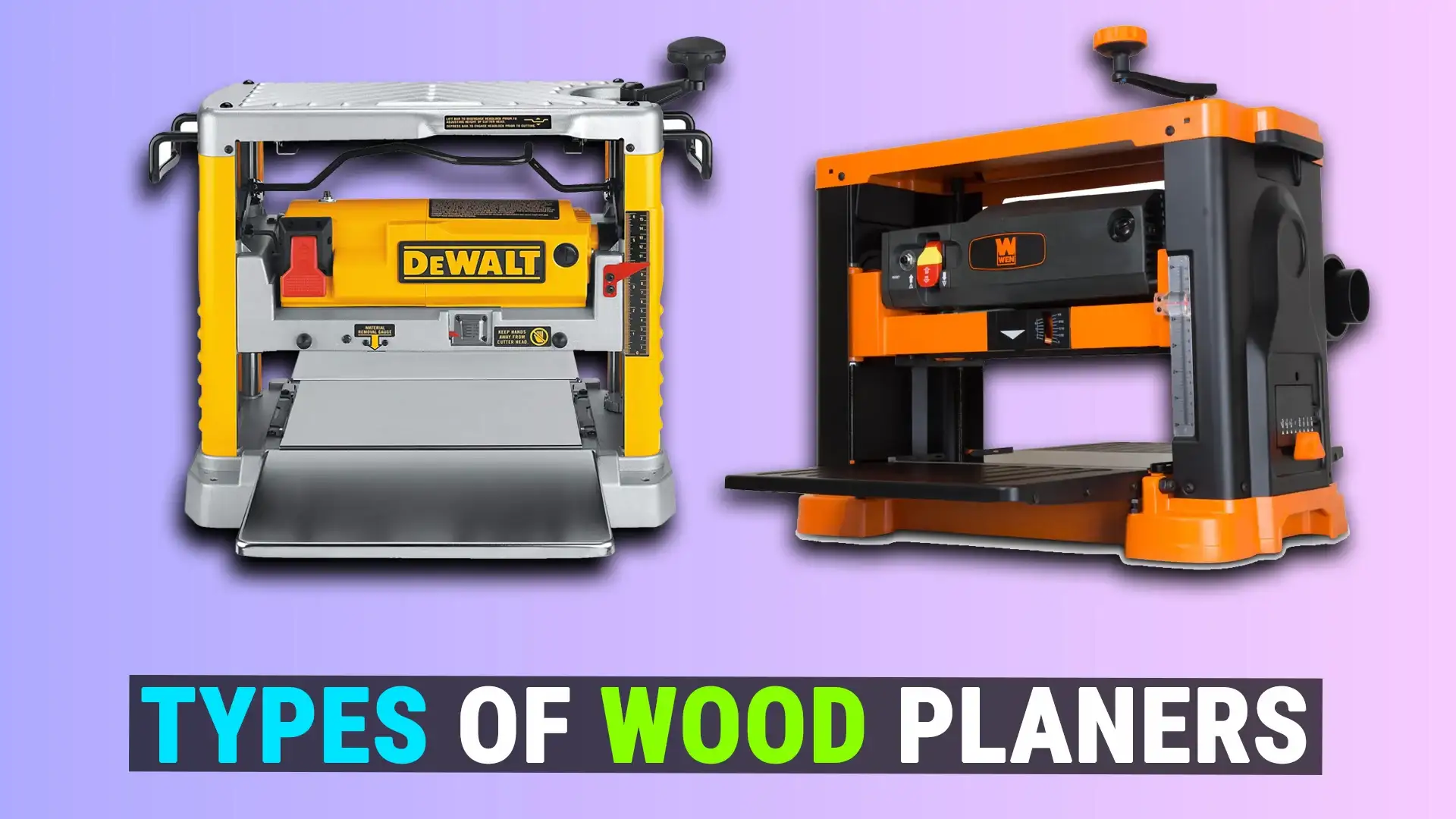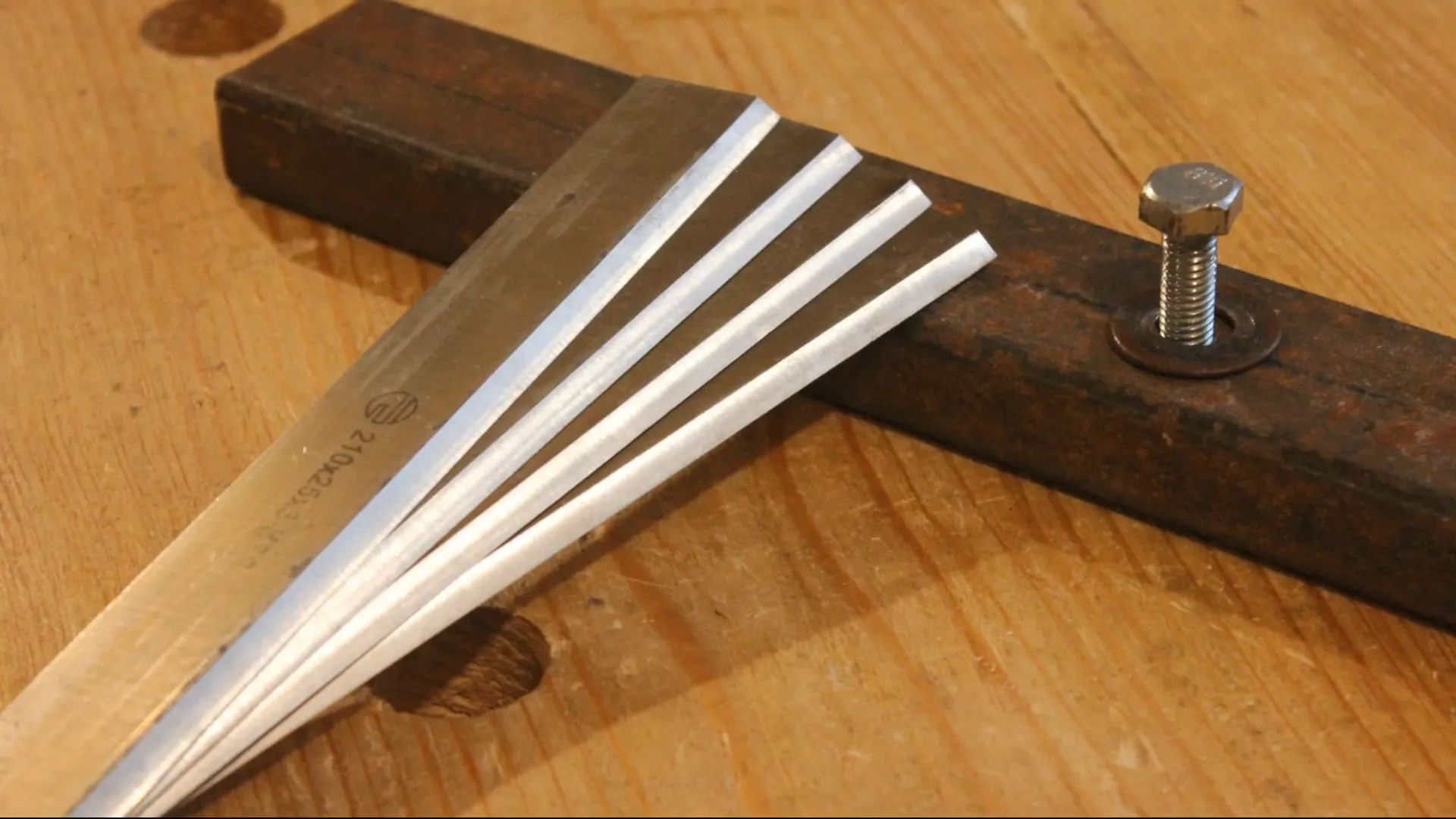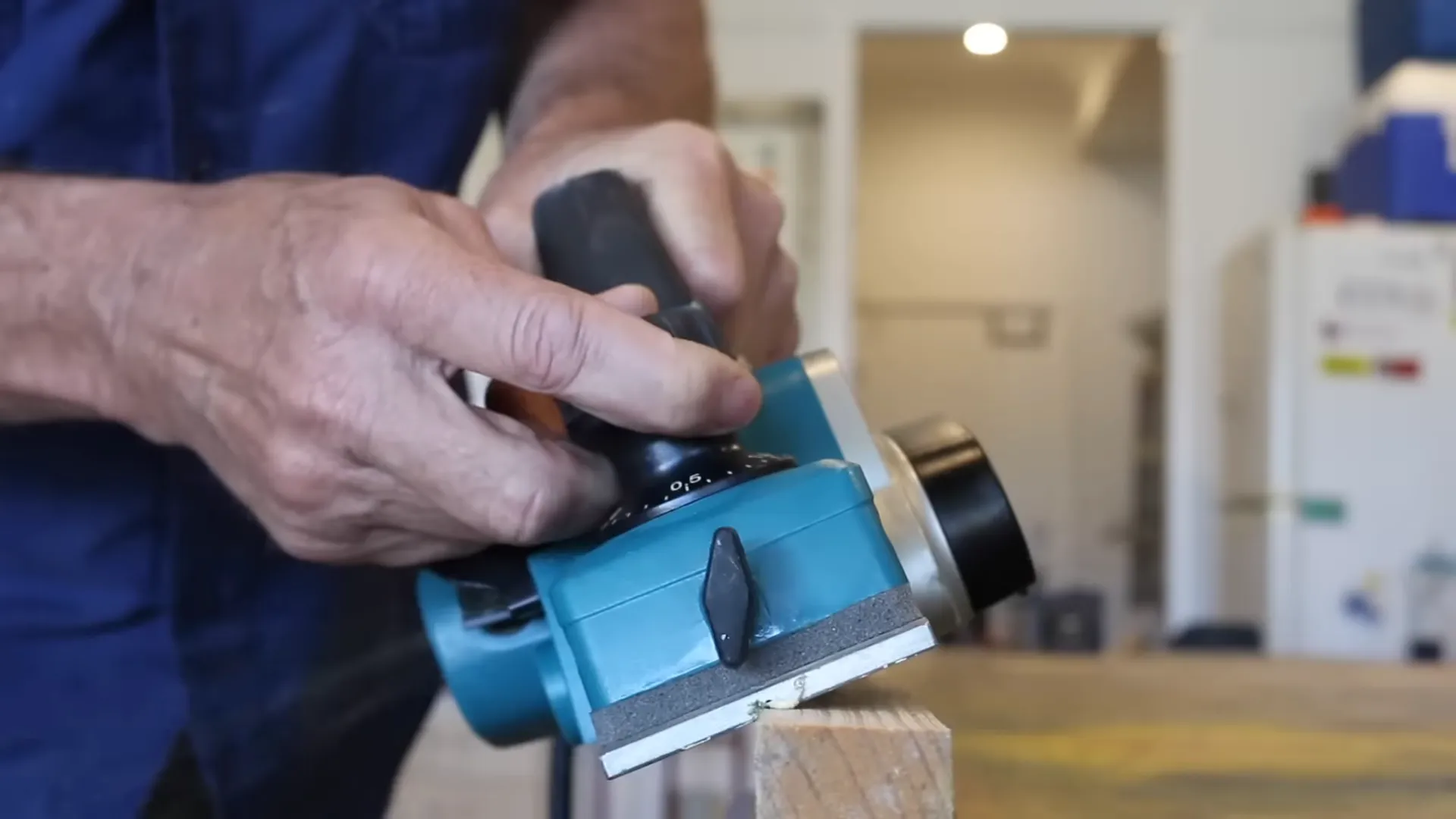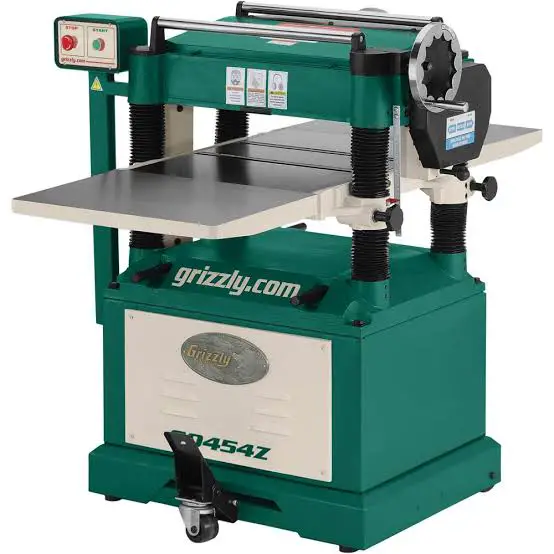11 Types Of Wood Planers You Need To Know [2024]
Woodworking is an art that has been around for centuries, and the use of wood planers has become increasingly popular in recent years.
For those who are not familiar with the term, a wood planer is a tool used to create smooth and even surfaces on boards and other pieces of wood.
But not all wood planers are created equal. There are various types of wood planers on the market that come with their own unique advantages and disadvantages.
This article will give you the 411 on all things related to wood planers – from what they are, to what types you can choose from – so that you can make an informed decision when it comes time to purchase one.
In other words, I’m going to help you hit the nail on the head!
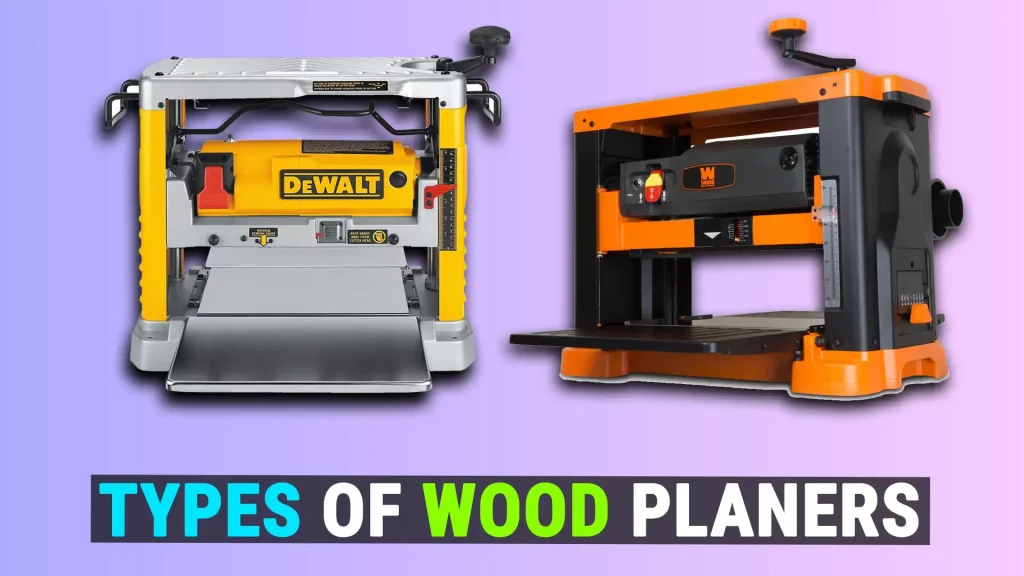
Manual Planers: Overview
Manual planers, also known as hand planers or wood planers, are essential tools for any woodworker.
They’re used to flatten and shape wood boards, creating smooth surfaces and straight edges. Manual planers are usually less expensive compared to power planers, but require more physical effort when in use.
Their simple design makes them easy to maintain and store away when not in use. Manual planers come in a variety of sizes, depending on the job you’re tackling.
Smaller models are perfect for detail work, while larger ones can be used for flat surfaces and heavier pieces of wood.
No matter what size you choose, manual planers provide excellent results with minimal effort. With that said, let’s move on to look at the uses and benefits of hand planers.
Hand Planer: Uses And Benefits
Using a hand planer is like sculpting your own masterpiece. With the right skill, the perfect tool and an eye for detail, you can shape any piece of wood into a work of art.
The hand planer has many uses and benefits that make it an indispensable tool in any woodworker’s arsenal:
- It offers greater control over the wood, allowing for precise shaping.
- It enables you to create curved edges or to even out rough patches on the surface of the wood.
- It can be used to create decorative grooves or patterns on the surface of the wood.
- It is lightweight and easy to use, making it ideal for small projects.
The hand planer also comes with a variety of attachments which allow you to expand its functionalities even further. You can find blades with different shapes and sizes that will enable you to tackle more ambitious projects.
In addition, you can use your hand planer in tight spaces where other tools might not fit. This makes it incredibly versatile and allows you to take on a variety of tasks with ease.
For all these reasons, using a hand planer is one of the most efficient ways for a woodworker to create precision pieces with minimal effort.
The flexibility and control offered by this tool make it an invaluable asset when working on intricate designs or detailed projects.
With a little practice and patience, anyone can master this technique and produce beautiful results every time!
Overall, using a hand planer provides numerous advantages over other tools available in the market today – from greater control over the material being shaped to more versatility when working with different types of woods or shapes.
Now that we have discussed some of the uses and benefits of this tool, let’s move on to looking at two-handed planers – their advantages and disadvantages next!
Two-Handed Planer: Advantages And Disadvantages
Two-handed planers, also referred to as block planers, are a type of woodworking tool used for smoothing and shaping wooden surfaces.
They’re often used for making furniture and other wooden objects. While they have some similarities to hand planers, two-handed planers offer more precision and control when working with wood.
The two-handed planer is equipped with two handles, one at the top and one at the bottom, which both need to be held in order to operate the tool.
This offers greater control over the plane’s movements since it requires both hands to move it around. The advantages of using a two-handed planer are numerous.
For starters, it can help reduce fatigue since it isn’t as physically demanding as a hand plane. Additionally, it allows you to get into tighter spaces than a hand plane due to its smaller size and lighter weight.
It also offers greater accuracy because both hands are needed in order to use the plane, which helps ensure that you achieve your desired results every time.
On the downside, two-handed planers may require additional time and effort when setting them up compared to hand planes since they have more parts that need to be adjusted before use.
Overall, two-handed planers provide users with plenty of benefits but also come with some drawbacks that shouldn’t be overlooked. Understanding these pros and cons can help you decide if this type of woodworking tool is right for your needs or not.
Combination Rasp Planer: Features And Limitations
The combination rasp planer is an incredibly useful and versatile tool for woodworking projects.
It has several features that make it a great choice for beginners and experienced woodworkers alike. However, there are also some limitations that should be taken into consideration before using the tool.
| Features | Limitations |
|---|---|
| Quickly shapes wood | Requires skill to use effectively |
| Good for delicate work | Not suitable for large jobs |
| Creates smooth finishes | Can cause gouging if not used properly |
When used correctly, the combination rasp planer is a great tool that can help create beautiful pieces of furniture or other woodwork projects.
Its small size and ability to shape curves make it ideal for detailed work, such as carving intricate designs or creating shallow grooves.
Additionally, its versatility allows it to be used on nearly any type of wood with ease. Yet, due to its small size and lack of power, it is not suitable for larger projects or rough shaping tasks.
Furthermore, the rasp planer requires skill to use effectively in order to avoid gouging or splintering the wood. Given these features and limitations of the combination rasp planer, it can be a great tool for those willing to learn how to use it properly and confidently.
With practice, users will gain better control over their cuts and be able to complete more detailed projects with ease.
Moving forward, we’ll explore the applications and drawbacks of flat plane bottom edge wood hand planers in greater detail.
Flat Plane Bottom Edge Wood Hand Planers: Applications And Drawbacks
Flat plane bottom edge wood hand planers are an essential tool for any woodworking enthusiast.
And, let’s be real – they’re the OG when it comes to cutting down boards and smoothing out those pesky knots and bumps.
These tools work wonders for creating a straight edge or trimming down a board to the exact dimensions you need.
But, in order for them to do their job correctly, you have to know how to use them properly. So, let’s take a closer look at flat plane bottom edge wood hand planers: their applications and drawbacks.
When it comes to applications, these tools are great for quickly trimming down any length of board or planing the edges of your project piece.
They can also be used to create chamfered edges on furniture pieces or even cut rabbets into boards. However, they can only be used on a flat surface due to their limited depth-of-cut capabilities.
Additionally, they won’t work well on curved surfaces as their blades are not designed for that purpose.
The main drawback of using flat plane bottom edge wood hand planers is that they tend to produce more noise than other types of power planers.
This means that if you’re planning on using them in close quarters (like inside your home) then you may want to invest in some hearing protection or soundproofing materials so as not to disturb anyone else in the area.
Additionally, because these tools require manual operation, they will take longer than many power tools when performing the same task – though this can sometimes be an advantage if you don’t need a perfectly smooth finish right away.
Overall, flat plane bottom edge wood hand planers are excellent tools for quickly trimming down boards and creating chamfered edges on furniture pieces – but just make sure you have the right hearing protection before getting started! With that said, let’s move onto discussing another type of woodworking tool – hand scrapers: characteristics and uses
Hand Scraper: Characteristics And Uses
Hand scrapers are a tool used in woodworking to produce a smooth finish on surfaces.
They’re one of the most versatile tools in the shop, but they require skill and practice to use effectively. Here’s an overview of hand scrapers and their characteristics and uses:
Characteristics:
- Hand scrapers come in many different sizes, shapes, and materials.
- They typically have a handle with a blade that’s made of either steel or carbon steel.
- The blade is sharpened to a fine edge for accuracy and precision when scraping.
- Some models also come with interchangeable blades for different tasks.
Uses:
- Hand scrapers can be used for planing, smoothing, shaping, and laminating wood surfaces.
- They’re ideal for difficult-to-reach areas where other power tools can’t fit or be used safely.
- Scrapers are also great for removing glue residue from joints, creating grooves in wood, chamfering edges, and creating decorative effects.
Scrapers are an essential tool for any serious woodworker as they provide precision control over the final result of any project.
With proper practice, these versatile tools can help you craft beautiful pieces with a perfect finish every time. With these qualities in mind, it’s no surprise that electric planers have become increasingly popular among hobbyists and professionals alike.
Electric Planers: Overview
Electric planers are becoming increasingly popular among woodworking professionals for their ease of use and portability.
They are versatile machines that can help you create smooth, even surfaces on your projects. In this section, we will take a look at the different types of electric planers available, as well as their pros and cons.
| Type | Pros | Cons |
|---|---|---|
| Electric Hand Planer | Lightweight & Portable; Can be used in tight spaces; Easy to use | Limited power compared to stationary models; Requires frequent sharpening of blades |
| Stationary Planer | More powerful than electric hand planers; Great for large-scale projects or materials like hardwood; Create smoother surfaces than electric hand planers | Difficult to transport and store; Not suitable for tight spaces or small-scale projects |
Electric planers come in two main varieties: electric hand planers and stationary planers.
The type you choose will depend on the type of project you’re working on, as well as the size and material of your workpiece.
Electric hand planers are lightweight and portable, making them ideal for smaller-scale projects or work in tight spots. However, they have limited power compared to stationary models, so they’re not suitable for larger projects or hardwoods.
Meanwhile, stationary planers offer more power than their electric counterparts and are great for large-scale projects or materials like hardwood.
They create smoother surfaces than electric hand planers but they’re tricky to transport and store.
Whether you opt for an electric hand planer or a stationary model, it’s important to consider the size of your project, the material you’re using, and whether portability is important before making a decision.
With these points in mind, let’s now take a look at the pros and cons of handheld planers.
Handheld Planer: Pros And Cons
Coincidentally, as electric planers have their benefits, so too do handheld planers.
Portable hand planers are widely used by woodworking experts and amateurs alike for a variety of tasks. Let’s explore the pros and cons of handheld planers.
One of the primary advantages of a handheld planer is its portability. It can be easily transported to any job site or carried around a workshop.
This makes it an ideal tool for those who must frequently move from one job location to another. Another benefit is that it requires less maintenance than an electric planer because it does not need to be plugged in or require replacement parts like motor brushes and belts.
However, there are also certain drawbacks to using a handheld planer that should be taken into consideration before making a purchase decision.
These include the limited cutting widths (usually no more than 3 inches), slower cutting speed, and increased physical effort required due to its manual operation mode.
Additionally, when using this type of tool, you must pay extra attention to safety precautions such as wearing protective gear and keeping fingers away from the moving blades while operating the device.
In short, although handheld planers offer convenience and portability, they may not be suitable for every woodworking project depending on your needs and preferences.
However, if you need a reliable tool for small projects on-site or in your workshop, then this type of device could be just what you’re looking for.
Bench Planer: Capabilities And Limitations
A bench planer is a type of wood planer used for planing and sanding boards that are wider than what could be handled by a handheld planer.
It’s an essential tool for any carpentry shop, as it allows for the precise and consistent cutting of large pieces of wood.
Bench planers come with a variety of features and specifications:
- Power: Bench planers have more powerful motors than handheld models, making them better suited to deal with tougher materials.
- Speed: Bench Planers typically operate at higher speeds than their handheld counterparts, resulting in quicker work times.
- Table Size: Bench Planers have larger tables, allowing you to work with wider boards more easily.
Bench planers also have some limitations that should be taken into consideration when selecting one for your shop:
- Bulkiness: Bench Planers are much heavier and more cumbersome than handheld models, making them difficult to move around.
- Noise Level: Bench Planers can be quite loud when in operation due to their powerful motors. They may require additional noise mitigation measures in busy workspaces.
- Cost: Bench Planers tend to be more expensive than other types of wood planers, due to their greater power and capacity.
The bench planer is an invaluable tool for any serious woodworker or carpenter who needs precision and accuracy in their projects.
It’s important to consider its capabilities and limitations before investing in one for your shop. With the right knowledge base about this type of wood planer, you’ll be able to make an informed decision about whether it meets your needs or not.
From there, you can move on to researching molding planer specifications and usage with confidence.
Molding Planer: Specifications And Usage
Ah, the molding planer.
A classic tool for those who truly understand the art of woodworking.
It is a type of planer that can make all kinds of intricate shapes and designs on a piece of wood, giving it character and adding to its beauty.
But before you dive in and start using this tool, let’s take a look at its specifications and usage.
| Specifications | Usage |
|---|---|
| Dual blades | Produce complex molding profiles on wood |
| Powerful motor | Cut hardwood without damaging the material |
| Adjustable depth control | Plane curved surfaces quickly and accurately |
| Easy to use handle | Change blade depth with ease for different cutting depths |
| Reversible feed direction | Make intricate grooves or dadoes in wood pieces with ease |
With these specifications and usages in mind, you should have no trouble creating beautiful pieces of art from your wooden projects.
Whether you want to create crown molding or detailed trim pieces, the molding planer will help you achieve your goals with ease.
Its adjustable blade depth, reversible feed direction and easy-to-use handle make it an ideal choice for any serious woodworker. So go ahead – grab a molding planer and get creative!
Stationary Planer: Operating Principles And Safety Guidelines
A stationary planer is a powerful woodworking tool that can smooth and shape wood quickly and accurately.
It works by feeding a piece of wood between two spinning blades, which cut the wood to the desired thickness.
Before using a stationary planer, it’s important to understand its operating principles and safety guidelines:
Operating Principles
- Feeding Wood Into the Planer:
- Make sure that you feed the wood in at a steady speed.
- Adjust the depth gauge on your machine so that only as much material is removed as desired. – Ensure that the piece of wood is held firmly against the fence before feeding it into the planer.
- Setting up Your Planer:
- Always check that all nuts, bolts, and screws are properly secured prior to use.
- Make sure all moving parts are free from any obstruction or debris before turning the power on. – Check for any signs of wear or damage to ensure optimal performance when working with your planer.
Safety Guidelines
- Wear Proper Safety Equipment:
- Always wear safety goggles while operating your planer. – Wear hearing protection if necessary when operating at high speeds or in noisy environments.
- Keep Children Away From The Planer:
- Keep children away from your stationary planer at all times while in use.
- Maintain Cleanliness Around The Planer:
- Regularly clean and inspect all parts of your machine regularly to prevent dust buildup and potential hazards while using your planer.
By following these operating principles and safety guidelines, you can ensure safe operation of your stationary planer with minimal risk involved.
With proper care and maintenance, you can enjoy efficient use of this powerful tool for years to come! Now let’s move on to understanding jointers – introduction to types…
Jointers: Introduction To Types
After discussing the operating principles and safety guidelines of a stationary planer, it is time to explore the world of jointers! Jointers are an incredible tool – they can breathe new life into any woodworking project with their ability to precisely trim, straighten, and square edges.
With jointers, no job is too challenging for even the most experienced woodworker. Let’s dive in and learn about the different types of jointers available today.
The two main types of jointers are stationary jointers and electric jointers.
Stationary jointers consist of a flat bed that runs along a pair of rails, which are usually adjustable depending on the size and thickness of the material being worked on.
Both the fence and table can be adjusted for accuracy when cutting or jointing boards. Electric jointers have similar features to stationary ones but feature an electric motor instead of relying on manual power.
They often come with variable speeds and include dust collection capabilities as well as an adjustable guide fence for accurate cuts every time.
Jointers also come in several different sizes ranging from small benchtop models to large floor-standing units. Some models may even include additional features such as a spiral cutterhead or helical cutter head to reduce vibration while cutting, making them ideal for heavier materials like hardwoods or metal.
Regardless of what model you choose, all types offer precision performance when cutting or jointing boards. With that in mind, let’s move on to learning about closed stand jointer: functions and maintenance instructions.
Closed Stand Jointer: Functions And Maintenance Instructions
Closed Stand Jointers are a popular wood planer for novice and experienced woodworkers alike.
They provide a great deal of stability and precision in creating smooth, straight edges. A Closed Stand Jointer consists of an adjustable fence, an infeed table, and an outfeed table mounted on a frame.
| In this section, we’ll discuss the functions and maintenance instructions of the closed stand jointer. | Functions | Maintenance Instructions |
|---|---|---|
| Precision Trimming | Sharpen Blades Regularly | |
| Smoothing Edges | Lubricate Moving Parts | |
| Straightening Boards | Clean Table Surface | |
| Cutting Tenon Joints | Adjust Fence Alignment |
With its adjustable fence and two tables, the closed-stand-jointer is able to perform precision trimming, smoothing edges, straightening boards and even cutting tenon joints.
The infeed table ensures that the wood is fed into the correct position at a consistent rate so that accurate cuts can be made with minimal effort.
The outfeed table helps keep the wood stable as it exits the jointer. To ensure optimal performance from your closed stand jointer, it is important to follow some basic maintenance instructions such as sharpening blades regularly to maintain accuracy of cuts, lubricating moving parts to reduce friction between them, cleaning table surfaces periodically to keep them free from debris buildup and adjusting fence alignment regularly to help achieve more precise results.
By following these functions and maintenance instructions carefully you can make sure that your closed stand jointer produces excellent results every time you use it.
Open Stand Jointer: Design Features And Advantages
An open stand jointer is like a woodworking jack of all trades.
It’s the perfect tool for crafting furniture, molding, and more. It is a must-have for any serious woodworker. Let us explore the design features and advantages of an open stand jointer.
Design Features:
- Bed Length:
- Longer beds are ideal for larger projects as they allow for more stock to be jointed in one pass.
- Shorter beds can be easier to maneuver around if space is limited.
Fence Angle and Tilt:
- The fence angle should be adjustable between 0° and 45° in order to accommodate different types of woodworking projects.
- The tilt should also be adjustable to allow for precise cuts at any angle.
Motor Power:
- A powerful motor will allow for faster cutting speeds with fewer passes over the workpiece.
Advantages:
- Versatility: An open stand jointer can handle a variety of tasks, from straightening boards to shaping curves in furniture pieces.
- Durability: Open stand jointers are designed to last and are built with heavy-duty components that won’t quit on you mid-project.
- Ease of Use: Open stand jointers are relatively easy to use, even for beginner woodworkers, thanks to their simple design and intuitive controls.
With these design features and advantages, it’s no wonder why an open stand jointer is such a valuable asset in any workshop!
Moving forward, we will discuss the usefulness & considerations of compact benchtop jointers & electric hand jointers.
Benchtop Jointers & Electric Hand Jointers: Usefulness & Considerations
Moving on from open stand jointers, benchtop jointers and electric hand jointers can be useful tools for many woodworking projects.
When deciding which type of planer is best for a particular project, it’s important to consider the features and benefits of each tool.
The following table summarizes some of the key features and considerations for benchtop jointers & electric hand jointers:
| Feature/Consideration | Benchtop Jointers | Electric Hand Jointers |
|---|---|---|
| Mobility | Portable, lightweight design allows for easy transport | Compact size allows for use in tight spaces or around corners |
| Power Source | Must be plugged into an electrical outlet | Battery powered; no need to be plugged in at all times |
| Intended Use | Ideal for occasional use on softwoods such as pine, fir, spruce, etc. | Suitable for larger jobs working with harder woods such as oak, walnut and mahogany |
When choosing between benchtop jointers & electric hand jointers, it’s important to take into account the intended use and size of the job.
For small-scale projects with softwoods such as pine or fir, a benchtop jointer may be more suitable due to its portability and ease of use.
On the other hand, electric hand jointers are better suited for larger jobs that require precision cuts on harder woods like oak or walnut.
Considerations such as power source and mobility should also factor into your decision making process when selecting the right planer for your project.
Conclusion
The art of woodworking is complex and requires a plethora of specialized tools. From manual planers to jointers, there are many options available for woodworkers.
With the right knowledge and know-how, any woodworking project can be successful. That being said, it is essential to understand the different types of planers and jointers available before beginning a project.
Manual planers are great for more precise cuts, while two-handed planers are best for larger projects that require more speed and power.
Combination rasp planer makes intricate details easier to accomplish, while flat plane bottom edge hand planers provide a smooth finish on even the toughest woods.
Jointers come in either closed stand or open stand versions, as well as benchtop or electric hand versions.
To sum it up, “A good craftsman never blames his tools” – one must choose the right tool for the job to ensure success in their woodworking endeavors.
From manual and two-handed planers to closed stand and open stand jointers, I hope this article provided an overview of the various types of woodworking tools so you can pick the perfect one for your project!.

